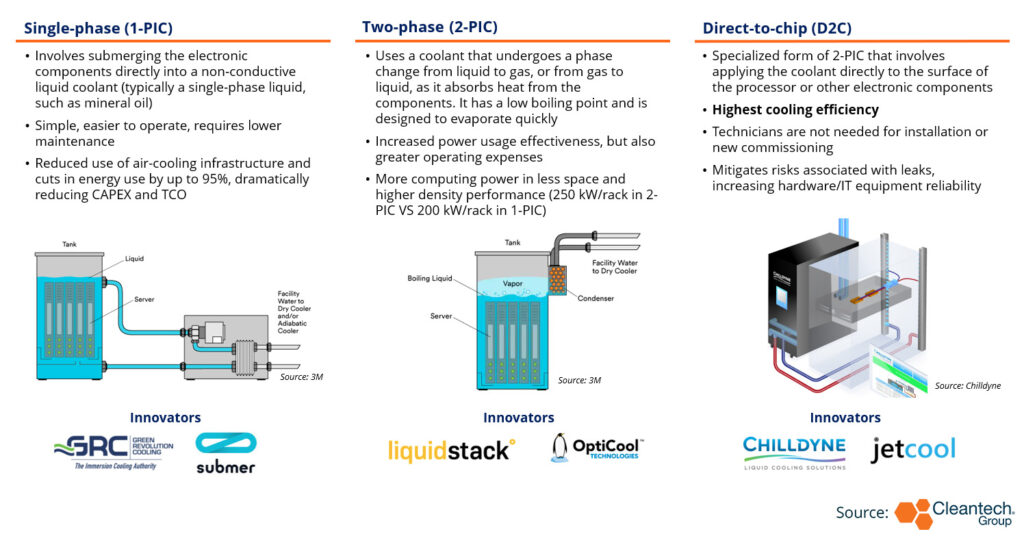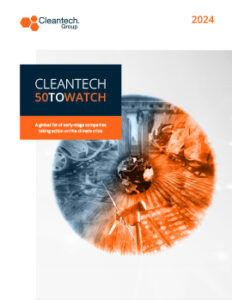Revolutionizing Data Center Cooling: Immersion Technologies at the Forefront
Data centers, the backbone of our digital world, have experienced exponential growth in recent years, leading to a significant increase in energy consumption. According to the International Energy Agency (IEA), data centers now account for 1% of all global electricity usage. In the U.S., the epicenter of technological innovation, the demand for data centers is projected to grow by approximately 10% annually until 2030. Emerging services and technologies such as streaming, cloud gaming, AI, blockchain, ML and VR are boosting demand for data services.
Cooling plays a critical role in data centers, accounting for approximately 40% of their energy consumption. As data centers face higher computing power requirements, innovative chip designs, and space constraints, the demand for efficient and effective cooling systems is growing. Immersion cooling is an emerging trend that addresses these challenges by offering a promising solution to increase cooling efficiency and manage the rising power density in data centers.
Immersion Cooling Impact
Immersion cooling is a method for cooling data center IT hardware by directly immersing the hardware in a non-conductive liquid. Liquid and immersion cooling solutions are gaining traction beyond traditional high-performance computing (HPC) and cryptocurrency markets. These advanced cooling methods offer higher efficiency and better thermal management, resulting in reduced energy consumption and improved performance.
Immersion cooling technologies enable the reduction or elimination of water usage in cooling system designs, leading to decreased operational costs. Additionally, immersion cooling presents the potential for energy reuse, enabling data centers to reduce their carbon emissions by up to 45% compared to traditional cooling methods.
Emerging Trends in Data Center Cooling
With over 20 innovators vying to establish themselves in the market, liquid cooling presents a promising alternative to traditional cooling methods. These innovators are exploring new approaches like single-phase, two-phase, and direct-to-chip cooling methods, by reducing the risk of leaks and enhancing efficiency.
The cooling market is experiencing significant growth, with its size projected to more than double and exceed $29B by 2028. Immersion cooling will grow from $270M at a 25% CAGR to $2.54B by 2032. Spending on liquid and immersion-cooling equipment by data center operators is expected to reach $1.1B or 19% of thermal management spending by 2026.
Immersion Cooling: Technology Types
Single-phase immersion cooling (1-PIC) involves circulating a liquid coolant directly over the heat-generating components, such as CPUs and GPUs, to absorb and carry away the heat. This method offers improved thermal conductivity compared to traditional air cooling, resulting in more efficient heat transfer and lower operating temperatures. It is actively used in cryptomining and some HPC applications for academia and government.
Two-phase cooling (2-PIC) takes liquid cooling to the next level by utilizing the phase change of a coolant from liquid to vapor. This method involves the circulation of a refrigerant that absorbs heat from the components, vaporizes, and then condenses back into a liquid state, releasing the heat elsewhere. Two-phase cooling offers even higher heat transfer efficiency than single-phase cooling, as the latent heat of vaporization enables the coolant to absorb more heat per unit volume. This method is particularly beneficial for extremely high-power-density applications, such as data tanks and actively used by large cloud service providers, where conventional cooling methods struggle to dissipate the heat effectively.
Direct-to-chip cooling, also known as microfluidic cooling, is a cutting-edge technique that involves integrating microchannels directly into the chip or package substrate. These microchannels allow a coolant to flow in close proximity to the heat-generating components, effectively absorbing and removing heat at its source.
Direct-to-chip cooling offers exceptional thermal management by minimizing the thermal resistance between the chip and the coolant, resulting in efficient heat dissipation and lower operating temperatures. This method enables precise cooling of individual chips or components, allowing for targeted temperature control and optimized performance.
The choice of cooling method depends on the specific requirements of the data center, such as power density, cooling efficiency, and the level of thermal control needed for different components or applications.
Leading the Change: Innovator Spotlight
Submer’s solutions serve as an example of single-phase liquid immersion cooling for data centers. It is one of the most active innovators in the industry. In February 2023, Submer deployed its solution in collaboration with Telefónica at Bellas Vistas’ central office in Madrid.
LiquidStack specializes in two-phase liquid immersion cooling solutions. It has launched the world’s first “immersion-cooled hyperscale data center” of 40 MW based in the Republic of Georgia that achieved 92.6% cooling energy savings with 90% less floor space compared to other enterprise data centers of 40MW. In April 2022, LiquidStack signed a partnership with Standard Power to develop an up to 12MW colocation data center, the first of its kind in the U.S.
Chilldyne presents a direct-to-chip liquid cooling solution for data centers and it owns a portfolio of IP for implementing direct-to-chip solutions. In 2021, Chilldyne signed a partnership with Schneider Electric to sell their systems. In May 2022, Chilldyne received an ARPA-E grant to improve thermal performance of cold plates and develop systems so they are easier to use. Chilldyne has already developed cooling systems for high power lasers for ASML, UAVs for Northrop Grumman, and rocket engines for DARPA.
What to Watch in Innovation
- If immersion cooling technologies advance, it will close today’s gap between immersion cooled infrastructure ($450k/MW) and air cooling ($200k/MW).
- Direct-to-chip technology is still novel but most efficient, likely to continue to be the main disruptor, with the highest CAGR expected in the next few years.
- Hyperscalers will continue investing in and adopting cooling solutions — optimizing energy efficiency, reducing carbon footprint, and enhancing overall sustainability of their data centers.
- When ecosystem members collaborate on standardization of design, metrics of effectiveness, components, and fluids, immersion cooling adoption will accelerate.




